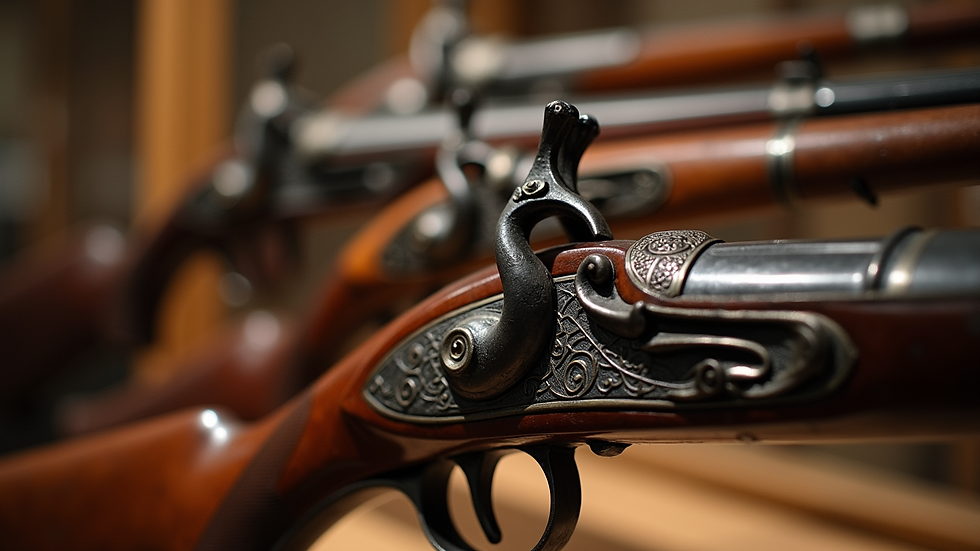A Global Journey of Weaponry from Ancient to Modern Times
- Heather

- Sep 17
- 5 min read
The evolution of weaponry tells a remarkable story of human creativity and conflict. As society has progressed, so have its tools for survival and combat. Starting from primitive stone tools, we have witnessed a transformation to advanced firearms and precision ammunition. This blog post will take you through the fascinating timeline of weaponry, highlighting its major developments and the impact these innovations have had on society and warfare.
Ancient Weaponry: The Dawn of Combat
In ancient civilizations, weaponry was crafted primarily for survival. Early humans fashioned tools from natural materials like stone, wood, and bone, gradually developing more advanced weaponry. The transition to metallurgy around 3,000 BCE represented a crucial turning point in weapon making, allowing societies to enhance their combat effectiveness.
The Age of Swords and Shields
During the Bronze Age, civilizations including the Egyptians, Greeks, and Romans began to mass-produce metal weapons. The gladius, a short sword used effectively by Roman soldiers, exemplifies the transition to more lethal close-combat weaponry. These swords were not merely tools of war; they represented military prowess and identity.

Shields became a vital aspect of combat as well. Warriors decorated them with intricate designs that indicated rank and heritage. For example, the Athenian hoplites famously used large, round shields, called hoplon, which were crucial for protecting both themselves and their comrades during battle.
The Rise of Archery
As societies advanced, so did their warfare tactics. The introduction of the bow and arrow revolutionized combat. The composite bow, made from wood, sinew, and horn, offered greater power and range. This innovation was widely utilized across various regions, especially by nomadic tribes.
A prime example is the English longbow, which played a decisive role during the Hundred Years' War. At the Battle of Agincourt in 1415, English archers decimated the French forces, demonstrating how ranged weaponry could turn the tide of battle.
The Medieval Era: Innovation and Warfare
The medieval era witnessed significant weapon advancements driven by the feudal system's demands for effective combat tools. Knights and their armor became symbols of this period’s warfare.
The Evolution of Firearms
The introduction of gunpowder in the 9th century dramatically changed warfare strategies. By the 15th century, weapons like hand cannons and arquebuses started appearing on the battlefield. These firearms allowed soldiers to inflict damage from a distance, shifting the landscape of combat.

Cannons, first developed in the 14th century, enabled armies to breach walls and fortifications once considered impenetrable. This combination of early firearms with traditional melee weapons paved the way for transformative combat strategies.
The Role of Knights and Chivalry
Knights, featuring heavy armor, epitomized medieval warfare. Their gear, especially including lances and swords, was crafted for mounted combat, which was vital during this time. The Code of Chivalry guided their actions, promoting ideals of honor and bravery.
Siege weaponry also emerged during this period, with tools like trebuchets and catapults used to breach fortified positions. This technology represented the ongoing struggle between attackers and defenders, pushing both sides to innovate continually.
The Age of Exploration: Global Influence on Weaponry
The 15th and 16th centuries marked the Age of Exploration, where European powers expanded their territories and connections, leading to widespread exchange of military technology.
The Impact of Colonialism
As European colonizers ventured into Africa, Asia, and the Americas, they brought advanced weaponry with them. Firearms such as muskets fundamentally altered the balance of power. Indigenous populations found themselves outmatched, leading to substantial power shifts. A stark example is the Spanish conquest of the Aztec Empire, where superior firearms and tactics were crucial to victory.

The Evolution of Ammunition
Ammunition technology also progressed during this time. The introduction of rifled barrels improved accuracy significantly. Additionally, the Minie ball, a conical bullet, enhanced both range and lethality, drastically changing the nature of battles and making them more deadly.
The Industrial Revolution: Mass Production and Modern Warfare
The Industrial Revolution, particularly during the 18th and 19th centuries, transformed weaponry, allowing for mass production. This shift made firearms and ammunition readily available to military forces worldwide.
The Rise of Modern Firearms
The 19th century brought new repeating firearms, including revolvers and lever-action rifles. These innovations allowed soldiers to shoot multiple rounds without needing to reload constantly, amplifying their firepower on the battlefield.
During the American Civil War, modern firearms played a significant role. The effectiveness of rifles and artillery required the development of new tactics, as traditional formations became increasingly susceptible to gunfire.
The Impact of World Wars
Both World Wars represented pivotal moments in weapon technology. The development of automatic weapons, tanks, and aircraft redefined combat. World War I introduced trench warfare, where troops faced the terrifying power of machine guns.
The urgency for innovation led to significant advancements, such as the introduction of tanks and aircraft that would dominate future conflicts. For instance, the B-29 Superfortress bomber, used in World War II, could carry a payload of up to 20,000 pounds of bombs, showcasing the escalating stakes of warfare.
The Cold War and Beyond: The Age of Technology
The Cold War era saw military technologies advance at breakneck speed, especially with the emergence of nuclear weapons. The arms race between the U.S. and the Soviet Union resulted in some of the most sophisticated weaponry to date.
The Nuclear Age
The bombings of Hiroshima and Nagasaki in 1945 marked a significant turn in military strategy, illustrating the devastating effects of nuclear bombs. This new reality fostered a policy of deterrence among superpowers.
As a result, the Cold War saw advancements in intercontinental ballistic missiles (ICBMs) and submarine-launched ballistic missiles (SLBMs). These innovations enabled nuclear payloads to be delivered over incredibly long distances, fundamentally altering global military strategy.
The Rise of Precision Weaponry
In recent decades, technological advancements have led to the rise of precision-guided munitions and drones. These innovations focus on accuracy while minimizing collateral damage, changing the face of modern warfare.
Drones are increasingly used for surveillance and targeted operations, raising ethical questions regarding remote military engagement. The success of drone strikes in conflicts, such as those in the Middle East, has reshaped military strategies and civilian perspectives on warfare.
Reflections on the Evolution of Weaponry
The history of weaponry from ancient times to today is a testament to human innovation and adaptability. As civilizations progressed, so did their means of resolving conflicts and asserting power.
From primitive stone tools to advanced technological systems, the development of weaponry has fundamentally influenced the course of history and the dynamics of society. Looking to the future, we must consider the implications of these advancements and the responsibility they entail.
The evolution of weapons is not solely about destruction; it also highlights our ongoing quest for peace in an ever-changing world where power balances are in constant flux.




Comments